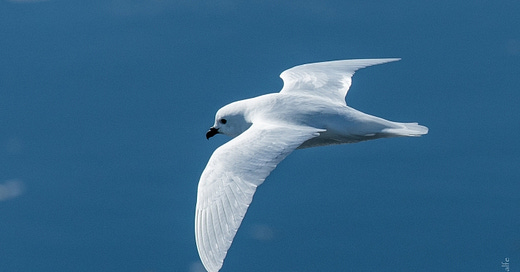It's very, very cold here in New York, so perhaps that's what put me in such an Antarctic state of mind for this week's Bird of the Week. Maybe I was looking for inspiration from the bird universe for how to make it through the winter doldrums. Well, I found it. Meet the snow petrel.
You can see why they call it the snow petrel. Honestly, if all snow was as blindingly beautiful as this bird, life would be better. I have to quote from Cornell's eBird database because the people running it are so bowled over by the snow petrel that they lapse into unexpected lyricism: "An unmistakable dreamlike vision of a bird, whiter than the snowy Antarctic peaks and glaciers against which it flies." Le romance! Le art! Le snow petrel!
Some brief facts: the snow petrel is reportedly one of just three birds that have been recorded at the South Pole, and has one of the two most southerly breeding ranges in the entire world! It is from Antarctica, it likes Antarctica, and it stays in Antarctica, chilling in every sense and eating fish and other seafood. If you head to Antarctica and look for an ice floe that is not shrinking rapidly thanks to the destruction caused by climate change (sigh) there is a chance you will see a bunch of snow petrels hanging out on it:
The above video also shows the snow petrel soaring over the frigid Antarctic waters, which is a wonderful sight. Here's another cute video of a bunch of petrels passing some time on a U.S. research ship:
It all seems like pretty normal bird stuff to me, except that this bird is exclusively found in the coldest part of the planet! A lot of birds leave Antarctica for some portion of the year, but the snow petrel has no need to go anywhere. It's not just living a casual bird life, it's thriving in conditions that frequently turn human beings into dead emblems of tragic folly. So how does the petrel pull it off? The answer is that, beyond standard stuff like feathers and webbed feet, we don't really know, according to this article from the ABC (the Australian one):
Snow petrels aren't a commonly researched bird.
"We don't know all that much about [snow petrels] compared with other species like penguins," [Australian Antarctic Division] ecologist Colin Southwell said.
But scientists are certain about one thing — they're tough.
"They don't look tough, they are quite an elegant bird," Dr Southwell said.
"They are quite delicate to look at [so] to live in the environments they live in — flying around in the ocean, breeding in places that have temperatures down to minus 40 [degrees Celsius] or so — is astonishing."
A bird of mystery! I love a bit of intrigue. I love a bird that puts human beings in their place.
Here's something we do know, though: the key to many mysteries about the snow petrel can be found in...its vomit. Seriously!
Snow petrels use vomit as a defense mechanism against predators like the evil skua, which makes sense. (If something throws up on you, you're likely to recoil.) It breeds and shelters in the many crevices of the rocky Antarctic landscape, and if something disturbs the nest, that something might get puked on. As Louise Emmerson, leader of the Seabird Research Group at the Australian Antarctic Division, told the ABC, "If it was a bird, it would cover their feathers in thick, goopy, oily, rich stuff and that would make the feathers really compromised in terms of their waterproof ability." Yikes!
But it's not just gross for gross' sake. The substance that the petrel throws up is actually a scientific gold mine. From Cornell's All About Birds site (emphasis mine):
In the polar cold the oil—a calorie-rich mixture that is the same stuff they feed their chicks—quickly hardens into a substance called mumiyo. Over time, the rocks around nests get thoroughly coated in the waxy material. Antarctica’s harsh climate allows little decomposition, and mumiyo deposits can build up to more than a foot thick.
[...] Beginning in the 1980s, scientists (including Achim Hiller of the University of Leipzig) realized that all the fishy smells and half-digested bits of krill contained in this buildup carried a record that was just waiting to be read. Applying standard radiocarbon dating, they learned that many of the petrel nest sites had been in use, more or less continuously, for more than 6,000 years, and the oldest ones had been used 34,000 years ago.
They probed this astounding history a bit further. Knowing that petrels nest on rock, not ice, they analyzed mumiyo from cliff faces spanning 5,000 vertical feet in five Antarctic regions. Measuring radiocarbon dates, they mapped when and where ice sheets had swelled or retreated during the planet’s most recent glacial period. In Antarctica’s barren interior, Snow Petrel vomit is about the only organic material common enough to do this with.
This is what's so good about birds. On the outside, a snow petrel is just a nice-looking bird. But scratch the surface, and it's a tough-as-nails survivor whose vomit holds the key to scientific wonders! May the snow petrel carry on puking and thriving forever.
A reminder: you can check out our complete Bird of the Week list here, and get in touch with your bird suggestions at hello@discourseblog.com.





